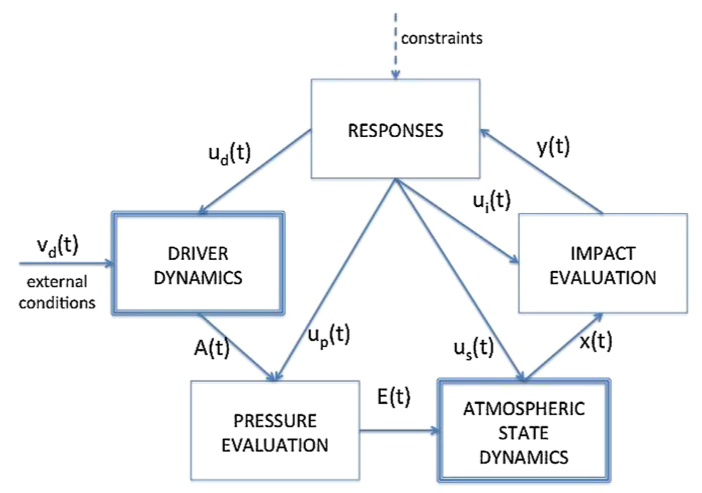Comprehensive Modeling Systems - DPSIR Basic

Integrated assessment modelling: a holistic approach to AQ&LC planning
Decision making in the field of air quality and greenhouses gases reductions can nowadays be supported by a clear overall framework and by computer tools that integrate the most relevant aspects of the problem. The general Drivers, Pressures, State, Impacts, Responses (DPSIR) scheme proposed by the European Environment Agency can be adapted to the specific case of local air quality policies and shows how the most recent scientific developments in impact evaluation and social acceptance can be integrated.
The DPSIR decision framework represents a general methodology to design Integrated Assessment Modelling (IAM) systems aimed at the implementation of effective Air Quality Plans (AQP).

Figure - A view of the links and structures of the blocks in the DPSIR scheme.
In particular, addressing air quality problems, the meaning of each block may be specified as follows (quotes are again from EEA glossary):
- DRIVERS: this block describes the “actions resulting from or influenced by human/natural activities or interventions” mainly intended to meet the social and individual needs. Here we refer to variables (often called “activity levels”) describing, for instance, traffic, industries, residential heating and food production. Natural phenomena like a changing solar radiation or the diffusion of volcanic dust may also be thought as part of this block.
- PRESSURES (Emissions): this block describes the “discharge of pollutants into the atmosphere from stationary sources such as smokestacks, and from surface areas of commercial or industrial facilities and mobile sources, for example, motor vehicles, locomotives and aircrafts.” PRESSURES depend on DRIVERS, and are computed as function of the activity levels and the quantity of pollutant emitted per activity unit.
- STATE (Air quality): this block describes the “condition of different environmental compartments and systems“. Here, we refer to STATE as the concentrations of air pollutants resulting from the PRESSURES defined in the previous block. In IAM implementations, STATE can sometimes be directly measured, but more often it is computed using some kind of air quality model.
- IMPACTS: this block describes “any alteration of environmental conditions or creation of a new set of environmental conditions, adverse or beneficial, caused or induced by an action or set of actions under consideration”. In the proposed framework, we refer to IMPACTS on human health, vegetation, ecosystem, derived by a modification of the STATE. Again the calculation of the IMPACTS may be based on some measure, but normally requires a set of models.
- RESPONSES: this block represents the core of the decision process, that is to say the set of techniques/approaches used to take decisions on activity changes, on emission reduction measures, on direct concentration reductions, or on impact attenuation.
For more information
Guariso, G., Maione, M., Volta, M. A decision framework for Integrated Assessment Modelling of air quality at regional and local scale (2016) Environmental Science and Policy, 65, pp. 3-12. DOI: 10.1016/j.envsci.2016.05.001 (PDF)
Note prepared by M. Volta (11/2021). For corrections or expansions please contact us.